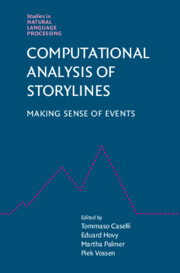Book contents
- Frontmatter
- Contents
- List of Contributors
- Introduction and Overview
- Part One Foundational Components of Storylines
- 1 The Role of Event-Based Representations and Reasoning in Language
- 2 The Rich Event Ontology: Ontological Hub for Event Representations
- 3 Decomposing Events and Storylines
- 4 Extracting and Aligning Timelines
- 5 Event Causality
- 6 A Narratology-Based Framework for Storyline Extraction
- Part Two Connecting the Dots: Resources, Tools, and Representations
- Author Index
4 - Extracting and Aligning Timelines
from Part One - Foundational Components of Storylines
Published online by Cambridge University Press: 06 November 2021
- Frontmatter
- Contents
- List of Contributors
- Introduction and Overview
- Part One Foundational Components of Storylines
- 1 The Role of Event-Based Representations and Reasoning in Language
- 2 The Rich Event Ontology: Ontological Hub for Event Representations
- 3 Decomposing Events and Storylines
- 4 Extracting and Aligning Timelines
- 5 Event Causality
- 6 A Narratology-Based Framework for Storyline Extraction
- Part Two Connecting the Dots: Resources, Tools, and Representations
- Author Index
Summary
Understanding the timeline of a story is a necessary first step for extracting storylines. This is difficult because timelines are rarely explicitly given in documents, and fragments of a story may be found across multiple documents. We outline prior work and the state of the art in both timeline extraction and alignment of events across documents. Previous work focused mainly on temporal graph extraction rather than actual timelines. Recently, there has been a growing interest in extracting timelines from these graphs. We review this work and describe our own approach that solves timeline extraction exactly. With regard to event alignment, most efforts have focused on the specific task of cross-document event coreference (CDEC). Current approaches to CDEC perform either event-only clustering or joint event–entity clustering, with neural methods achieving the best results. We outline next steps to advance the field toward full timeline alignment across documents that can serve as a foundation for extraction of higher-level, more abstract storylines.
Keywords
- Type
- Chapter
- Information
- Computational Analysis of StorylinesMaking Sense of Events, pp. 87 - 105Publisher: Cambridge University PressPrint publication year: 2021

